Evaluating Zara's Logistics and Supply Chain Management Approach
VerifiedAdded on 2023/06/16
|12
|3139
|257
Report
AI Summary
This report provides an in-depth analysis of Zara's logistics and supply chain management strategies, highlighting its customer-centric approach and competitive advantages within the global fashion industry. It examines Zara's manufacturing and supply chain patterns, organizational culture, and knowledge management, comparing its business strategy to those of Dell and Myers. The report contrasts Zara's vertically integrated supply chain with Dell's horizontally integrated model, emphasizing Zara's control over the entire process from design to delivery. It also discusses Zara's competitive advantages, including its quick product delivery, vertical integration, and implementation of just-in-time (JIT) systems, ultimately attributing Zara's success to its strategic management and understanding of core competencies. Desklib offers similar solved assignments and past papers for students.
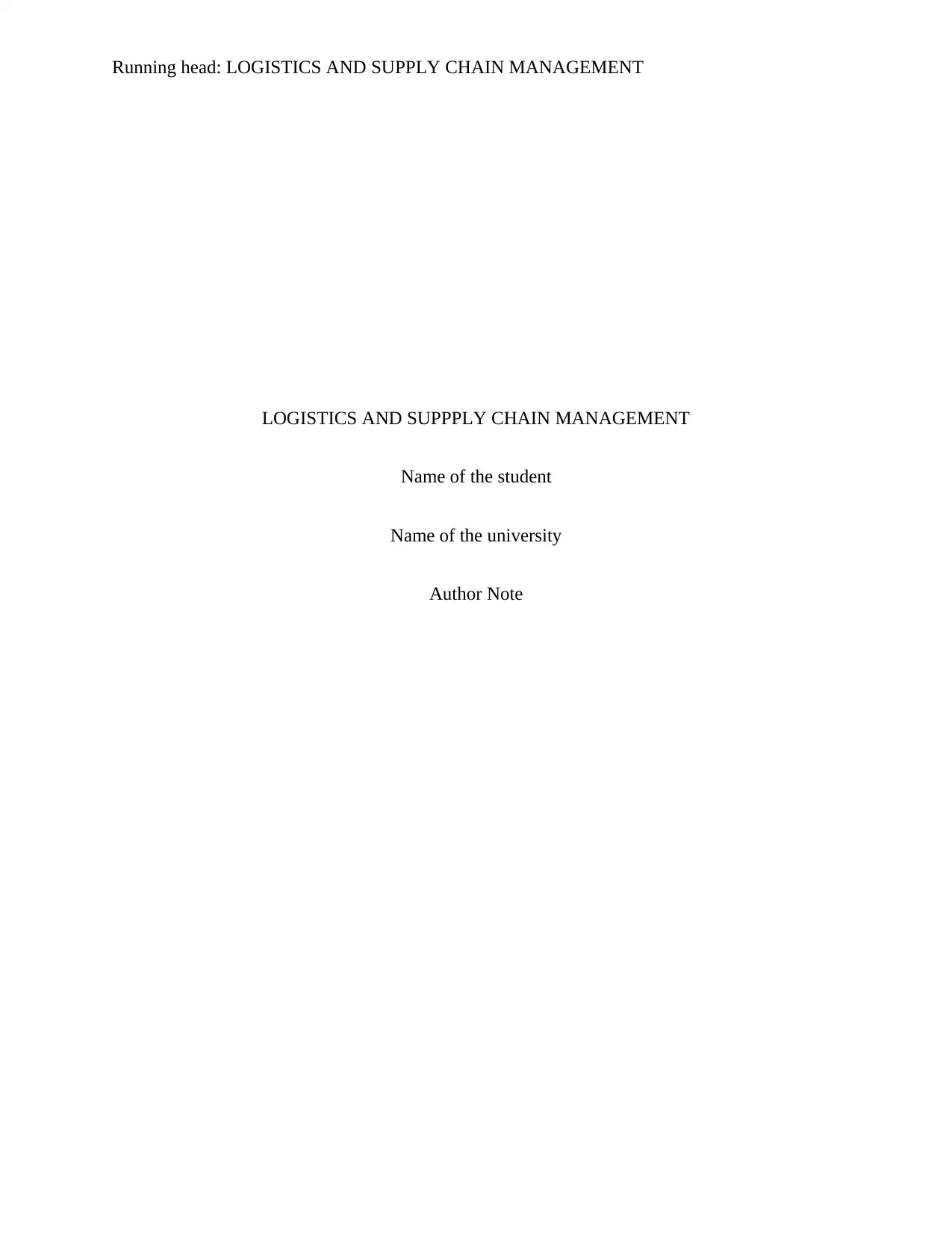
Running head: LOGISTICS AND SUPPLY CHAIN MANAGEMENT
LOGISTICS AND SUPPPLY CHAIN MANAGEMENT
Name of the student
Name of the university
Author Note
LOGISTICS AND SUPPPLY CHAIN MANAGEMENT
Name of the student
Name of the university
Author Note
Paraphrase This Document
Need a fresh take? Get an instant paraphrase of this document with our AI Paraphraser
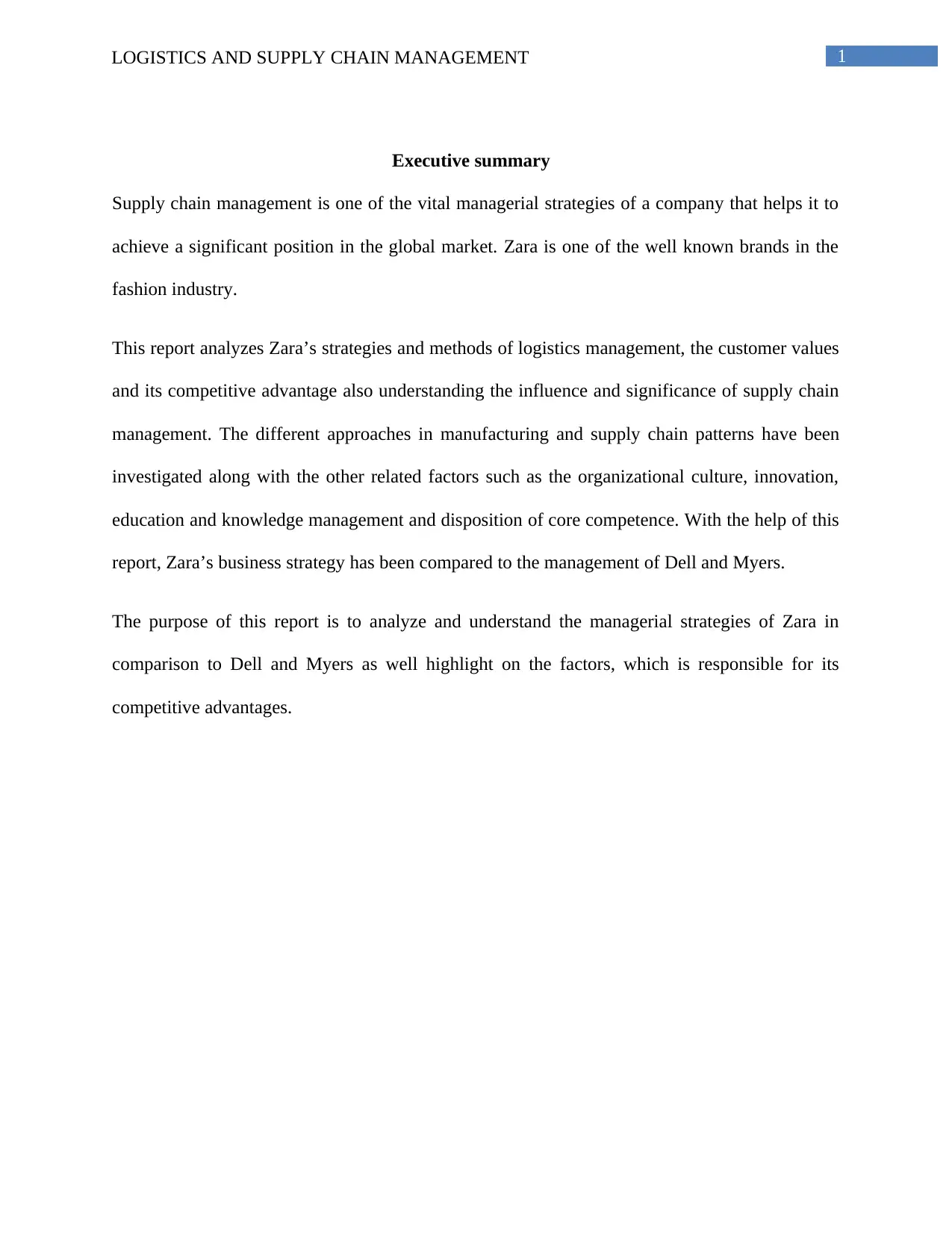
1LOGISTICS AND SUPPLY CHAIN MANAGEMENT
Executive summary
Supply chain management is one of the vital managerial strategies of a company that helps it to
achieve a significant position in the global market. Zara is one of the well known brands in the
fashion industry.
This report analyzes Zara’s strategies and methods of logistics management, the customer values
and its competitive advantage also understanding the influence and significance of supply chain
management. The different approaches in manufacturing and supply chain patterns have been
investigated along with the other related factors such as the organizational culture, innovation,
education and knowledge management and disposition of core competence. With the help of this
report, Zara’s business strategy has been compared to the management of Dell and Myers.
The purpose of this report is to analyze and understand the managerial strategies of Zara in
comparison to Dell and Myers as well highlight on the factors, which is responsible for its
competitive advantages.
Executive summary
Supply chain management is one of the vital managerial strategies of a company that helps it to
achieve a significant position in the global market. Zara is one of the well known brands in the
fashion industry.
This report analyzes Zara’s strategies and methods of logistics management, the customer values
and its competitive advantage also understanding the influence and significance of supply chain
management. The different approaches in manufacturing and supply chain patterns have been
investigated along with the other related factors such as the organizational culture, innovation,
education and knowledge management and disposition of core competence. With the help of this
report, Zara’s business strategy has been compared to the management of Dell and Myers.
The purpose of this report is to analyze and understand the managerial strategies of Zara in
comparison to Dell and Myers as well highlight on the factors, which is responsible for its
competitive advantages.
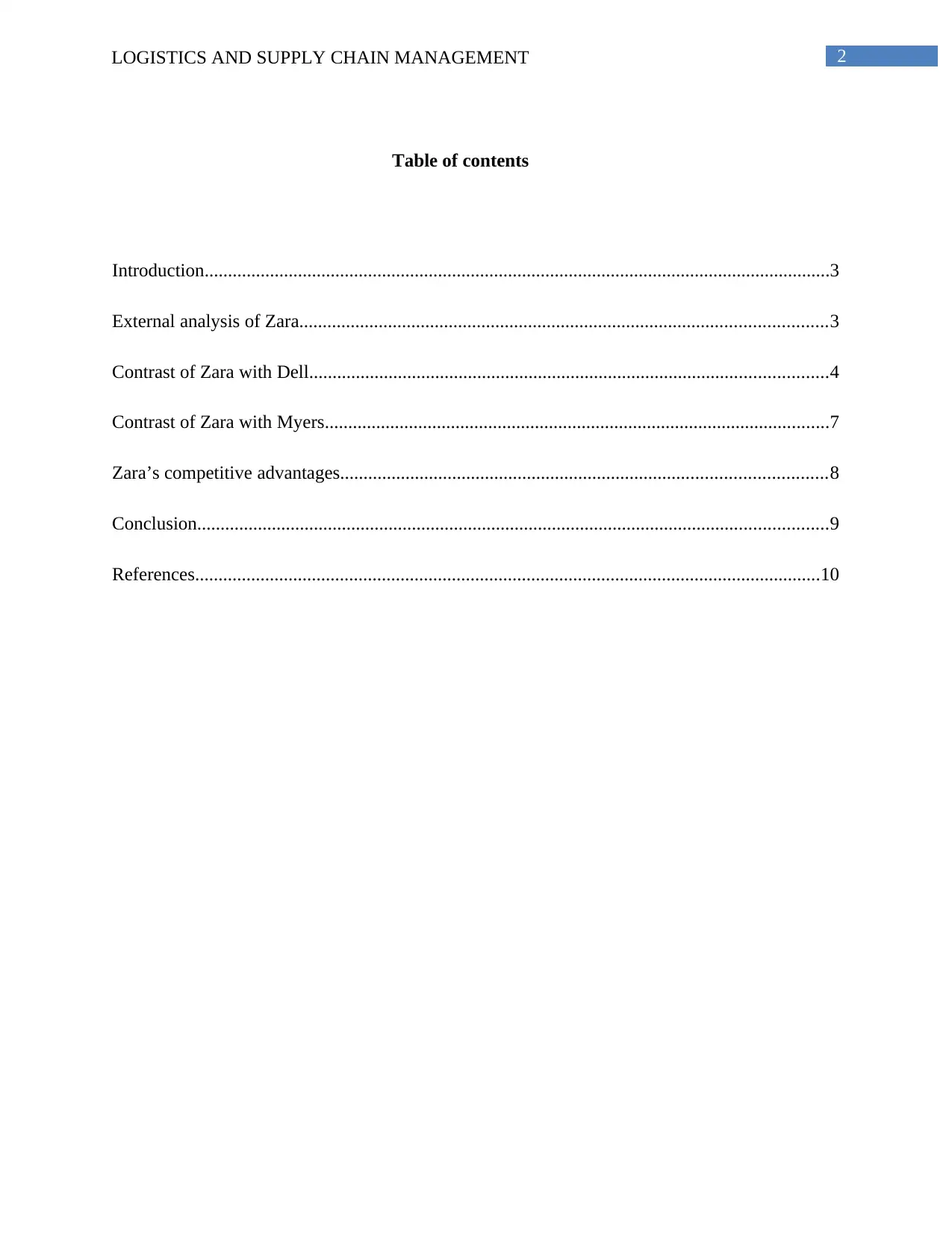
2LOGISTICS AND SUPPLY CHAIN MANAGEMENT
Table of contents
Introduction......................................................................................................................................3
External analysis of Zara.................................................................................................................3
Contrast of Zara with Dell...............................................................................................................4
Contrast of Zara with Myers............................................................................................................7
Zara’s competitive advantages........................................................................................................8
Conclusion.......................................................................................................................................9
References......................................................................................................................................10
Table of contents
Introduction......................................................................................................................................3
External analysis of Zara.................................................................................................................3
Contrast of Zara with Dell...............................................................................................................4
Contrast of Zara with Myers............................................................................................................7
Zara’s competitive advantages........................................................................................................8
Conclusion.......................................................................................................................................9
References......................................................................................................................................10
⊘ This is a preview!⊘
Do you want full access?
Subscribe today to unlock all pages.

Trusted by 1+ million students worldwide
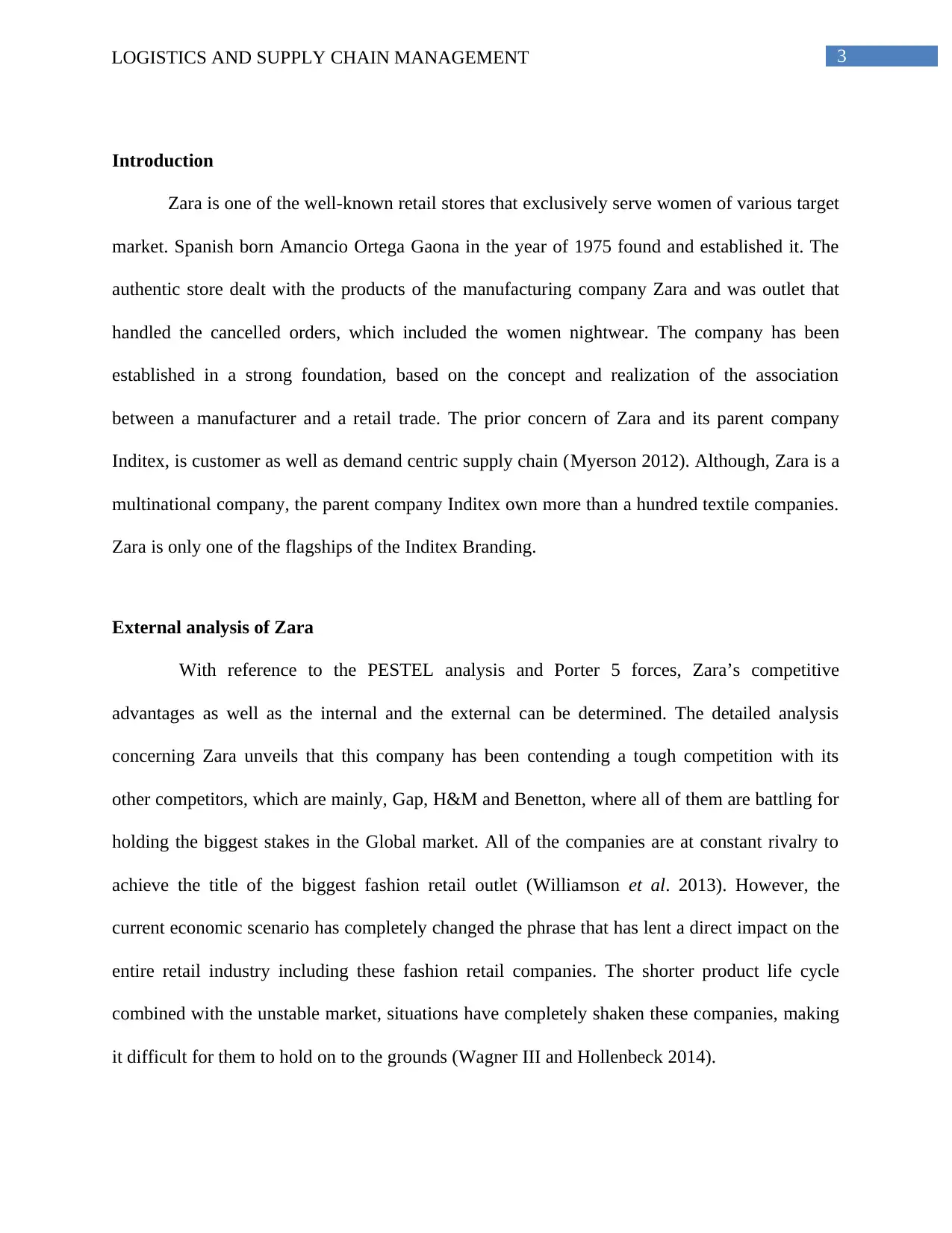
3LOGISTICS AND SUPPLY CHAIN MANAGEMENT
Introduction
Zara is one of the well-known retail stores that exclusively serve women of various target
market. Spanish born Amancio Ortega Gaona in the year of 1975 found and established it. The
authentic store dealt with the products of the manufacturing company Zara and was outlet that
handled the cancelled orders, which included the women nightwear. The company has been
established in a strong foundation, based on the concept and realization of the association
between a manufacturer and a retail trade. The prior concern of Zara and its parent company
Inditex, is customer as well as demand centric supply chain (Myerson 2012). Although, Zara is a
multinational company, the parent company Inditex own more than a hundred textile companies.
Zara is only one of the flagships of the Inditex Branding.
External analysis of Zara
With reference to the PESTEL analysis and Porter 5 forces, Zara’s competitive
advantages as well as the internal and the external can be determined. The detailed analysis
concerning Zara unveils that this company has been contending a tough competition with its
other competitors, which are mainly, Gap, H&M and Benetton, where all of them are battling for
holding the biggest stakes in the Global market. All of the companies are at constant rivalry to
achieve the title of the biggest fashion retail outlet (Williamson et al. 2013). However, the
current economic scenario has completely changed the phrase that has lent a direct impact on the
entire retail industry including these fashion retail companies. The shorter product life cycle
combined with the unstable market, situations have completely shaken these companies, making
it difficult for them to hold on to the grounds (Wagner III and Hollenbeck 2014).
Introduction
Zara is one of the well-known retail stores that exclusively serve women of various target
market. Spanish born Amancio Ortega Gaona in the year of 1975 found and established it. The
authentic store dealt with the products of the manufacturing company Zara and was outlet that
handled the cancelled orders, which included the women nightwear. The company has been
established in a strong foundation, based on the concept and realization of the association
between a manufacturer and a retail trade. The prior concern of Zara and its parent company
Inditex, is customer as well as demand centric supply chain (Myerson 2012). Although, Zara is a
multinational company, the parent company Inditex own more than a hundred textile companies.
Zara is only one of the flagships of the Inditex Branding.
External analysis of Zara
With reference to the PESTEL analysis and Porter 5 forces, Zara’s competitive
advantages as well as the internal and the external can be determined. The detailed analysis
concerning Zara unveils that this company has been contending a tough competition with its
other competitors, which are mainly, Gap, H&M and Benetton, where all of them are battling for
holding the biggest stakes in the Global market. All of the companies are at constant rivalry to
achieve the title of the biggest fashion retail outlet (Williamson et al. 2013). However, the
current economic scenario has completely changed the phrase that has lent a direct impact on the
entire retail industry including these fashion retail companies. The shorter product life cycle
combined with the unstable market, situations have completely shaken these companies, making
it difficult for them to hold on to the grounds (Wagner III and Hollenbeck 2014).
Paraphrase This Document
Need a fresh take? Get an instant paraphrase of this document with our AI Paraphraser
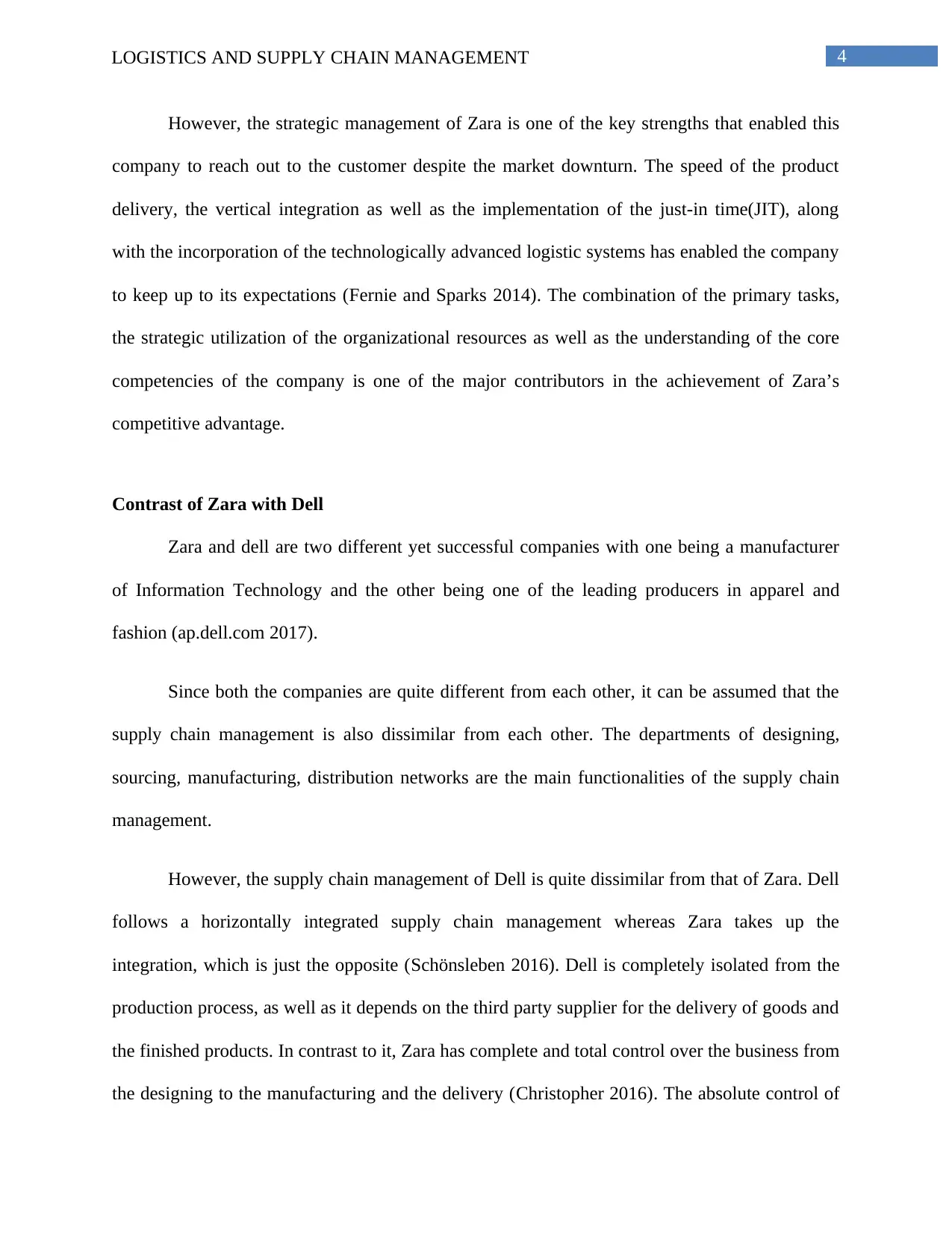
4LOGISTICS AND SUPPLY CHAIN MANAGEMENT
However, the strategic management of Zara is one of the key strengths that enabled this
company to reach out to the customer despite the market downturn. The speed of the product
delivery, the vertical integration as well as the implementation of the just-in time(JIT), along
with the incorporation of the technologically advanced logistic systems has enabled the company
to keep up to its expectations (Fernie and Sparks 2014). The combination of the primary tasks,
the strategic utilization of the organizational resources as well as the understanding of the core
competencies of the company is one of the major contributors in the achievement of Zara’s
competitive advantage.
Contrast of Zara with Dell
Zara and dell are two different yet successful companies with one being a manufacturer
of Information Technology and the other being one of the leading producers in apparel and
fashion (ap.dell.com 2017).
Since both the companies are quite different from each other, it can be assumed that the
supply chain management is also dissimilar from each other. The departments of designing,
sourcing, manufacturing, distribution networks are the main functionalities of the supply chain
management.
However, the supply chain management of Dell is quite dissimilar from that of Zara. Dell
follows a horizontally integrated supply chain management whereas Zara takes up the
integration, which is just the opposite (Schönsleben 2016). Dell is completely isolated from the
production process, as well as it depends on the third party supplier for the delivery of goods and
the finished products. In contrast to it, Zara has complete and total control over the business from
the designing to the manufacturing and the delivery (Christopher 2016). The absolute control of
However, the strategic management of Zara is one of the key strengths that enabled this
company to reach out to the customer despite the market downturn. The speed of the product
delivery, the vertical integration as well as the implementation of the just-in time(JIT), along
with the incorporation of the technologically advanced logistic systems has enabled the company
to keep up to its expectations (Fernie and Sparks 2014). The combination of the primary tasks,
the strategic utilization of the organizational resources as well as the understanding of the core
competencies of the company is one of the major contributors in the achievement of Zara’s
competitive advantage.
Contrast of Zara with Dell
Zara and dell are two different yet successful companies with one being a manufacturer
of Information Technology and the other being one of the leading producers in apparel and
fashion (ap.dell.com 2017).
Since both the companies are quite different from each other, it can be assumed that the
supply chain management is also dissimilar from each other. The departments of designing,
sourcing, manufacturing, distribution networks are the main functionalities of the supply chain
management.
However, the supply chain management of Dell is quite dissimilar from that of Zara. Dell
follows a horizontally integrated supply chain management whereas Zara takes up the
integration, which is just the opposite (Schönsleben 2016). Dell is completely isolated from the
production process, as well as it depends on the third party supplier for the delivery of goods and
the finished products. In contrast to it, Zara has complete and total control over the business from
the designing to the manufacturing and the delivery (Christopher 2016). The absolute control of
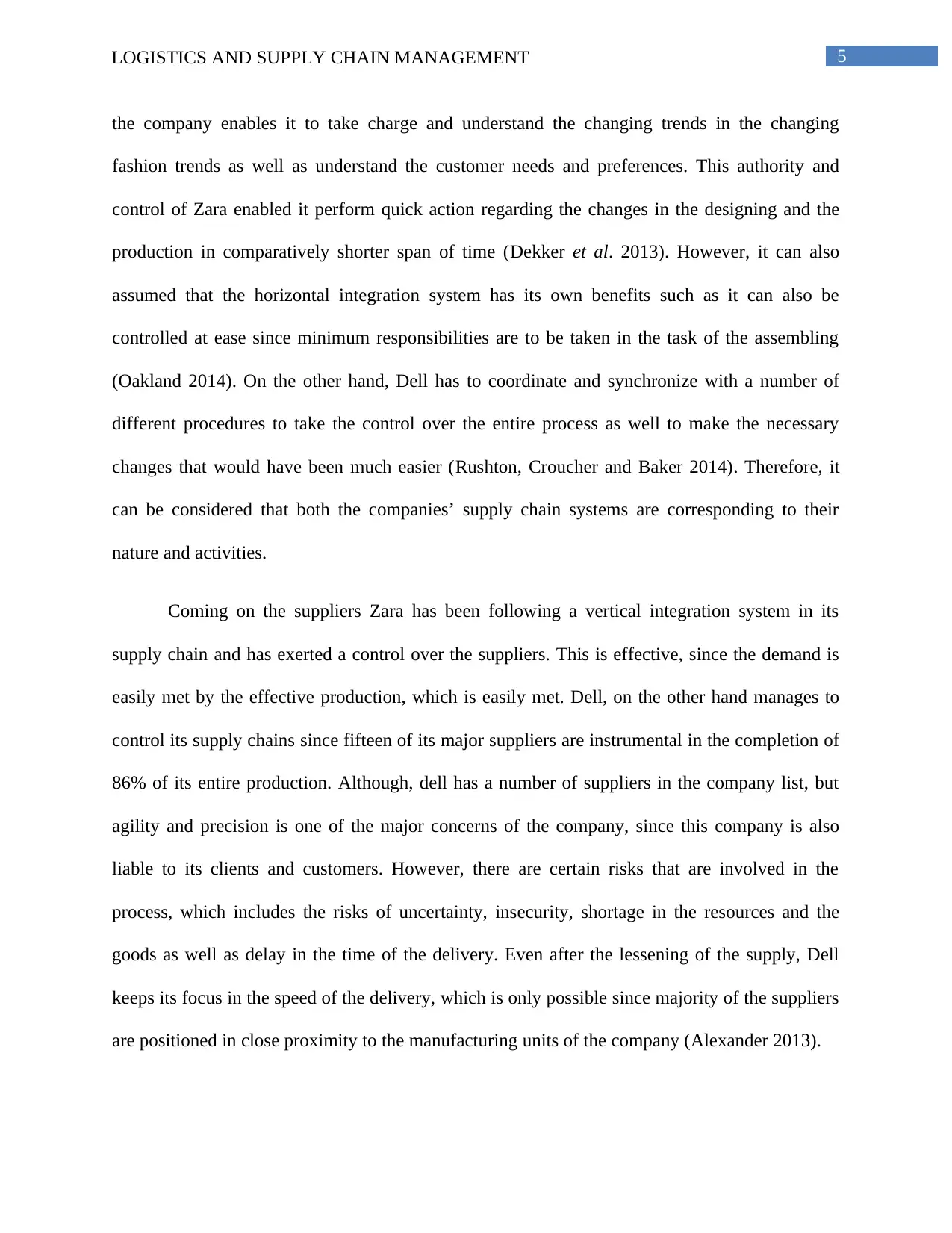
5LOGISTICS AND SUPPLY CHAIN MANAGEMENT
the company enables it to take charge and understand the changing trends in the changing
fashion trends as well as understand the customer needs and preferences. This authority and
control of Zara enabled it perform quick action regarding the changes in the designing and the
production in comparatively shorter span of time (Dekker et al. 2013). However, it can also
assumed that the horizontal integration system has its own benefits such as it can also be
controlled at ease since minimum responsibilities are to be taken in the task of the assembling
(Oakland 2014). On the other hand, Dell has to coordinate and synchronize with a number of
different procedures to take the control over the entire process as well to make the necessary
changes that would have been much easier (Rushton, Croucher and Baker 2014). Therefore, it
can be considered that both the companies’ supply chain systems are corresponding to their
nature and activities.
Coming on the suppliers Zara has been following a vertical integration system in its
supply chain and has exerted a control over the suppliers. This is effective, since the demand is
easily met by the effective production, which is easily met. Dell, on the other hand manages to
control its supply chains since fifteen of its major suppliers are instrumental in the completion of
86% of its entire production. Although, dell has a number of suppliers in the company list, but
agility and precision is one of the major concerns of the company, since this company is also
liable to its clients and customers. However, there are certain risks that are involved in the
process, which includes the risks of uncertainty, insecurity, shortage in the resources and the
goods as well as delay in the time of the delivery. Even after the lessening of the supply, Dell
keeps its focus in the speed of the delivery, which is only possible since majority of the suppliers
are positioned in close proximity to the manufacturing units of the company (Alexander 2013).
the company enables it to take charge and understand the changing trends in the changing
fashion trends as well as understand the customer needs and preferences. This authority and
control of Zara enabled it perform quick action regarding the changes in the designing and the
production in comparatively shorter span of time (Dekker et al. 2013). However, it can also
assumed that the horizontal integration system has its own benefits such as it can also be
controlled at ease since minimum responsibilities are to be taken in the task of the assembling
(Oakland 2014). On the other hand, Dell has to coordinate and synchronize with a number of
different procedures to take the control over the entire process as well to make the necessary
changes that would have been much easier (Rushton, Croucher and Baker 2014). Therefore, it
can be considered that both the companies’ supply chain systems are corresponding to their
nature and activities.
Coming on the suppliers Zara has been following a vertical integration system in its
supply chain and has exerted a control over the suppliers. This is effective, since the demand is
easily met by the effective production, which is easily met. Dell, on the other hand manages to
control its supply chains since fifteen of its major suppliers are instrumental in the completion of
86% of its entire production. Although, dell has a number of suppliers in the company list, but
agility and precision is one of the major concerns of the company, since this company is also
liable to its clients and customers. However, there are certain risks that are involved in the
process, which includes the risks of uncertainty, insecurity, shortage in the resources and the
goods as well as delay in the time of the delivery. Even after the lessening of the supply, Dell
keeps its focus in the speed of the delivery, which is only possible since majority of the suppliers
are positioned in close proximity to the manufacturing units of the company (Alexander 2013).
⊘ This is a preview!⊘
Do you want full access?
Subscribe today to unlock all pages.

Trusted by 1+ million students worldwide
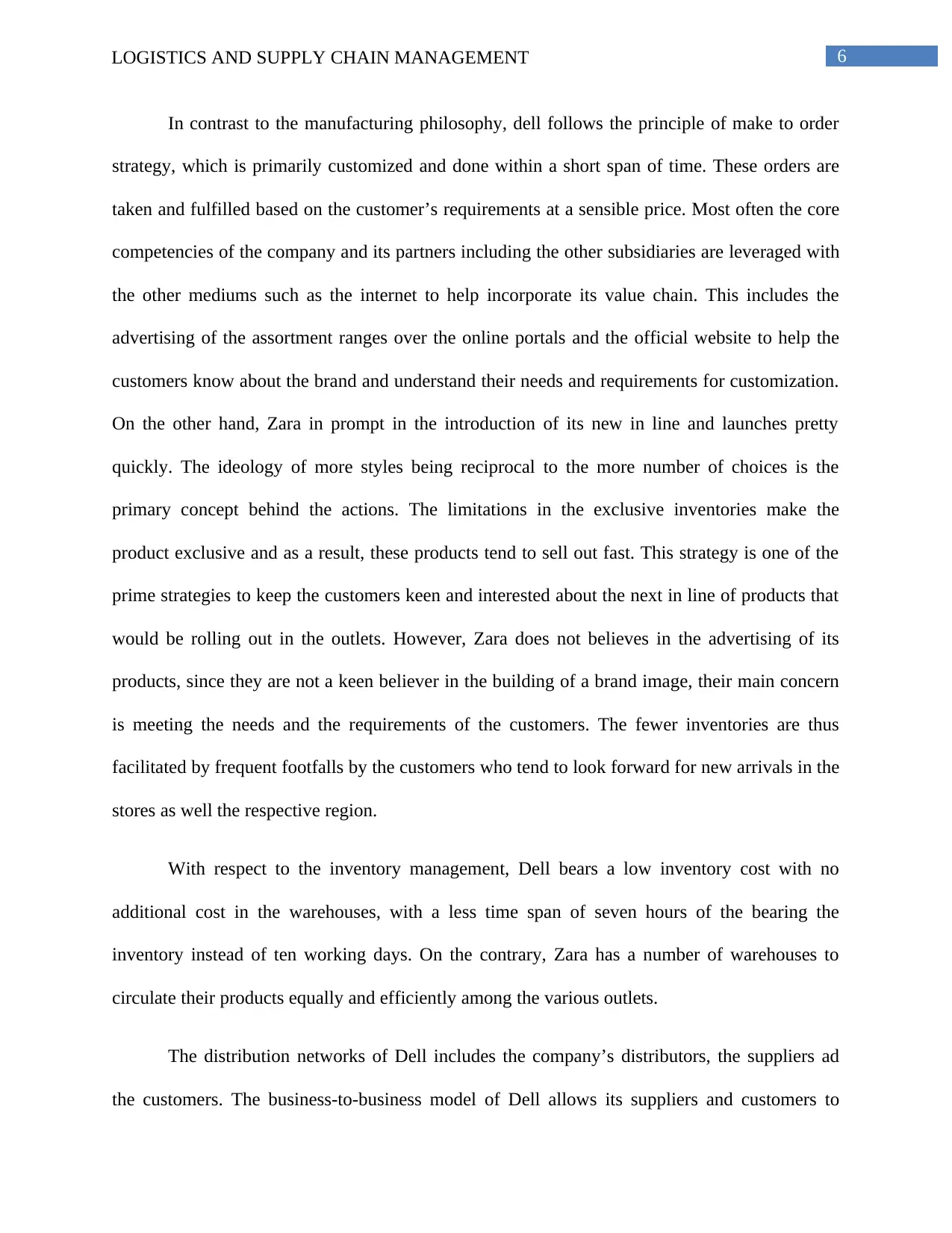
6LOGISTICS AND SUPPLY CHAIN MANAGEMENT
In contrast to the manufacturing philosophy, dell follows the principle of make to order
strategy, which is primarily customized and done within a short span of time. These orders are
taken and fulfilled based on the customer’s requirements at a sensible price. Most often the core
competencies of the company and its partners including the other subsidiaries are leveraged with
the other mediums such as the internet to help incorporate its value chain. This includes the
advertising of the assortment ranges over the online portals and the official website to help the
customers know about the brand and understand their needs and requirements for customization.
On the other hand, Zara in prompt in the introduction of its new in line and launches pretty
quickly. The ideology of more styles being reciprocal to the more number of choices is the
primary concept behind the actions. The limitations in the exclusive inventories make the
product exclusive and as a result, these products tend to sell out fast. This strategy is one of the
prime strategies to keep the customers keen and interested about the next in line of products that
would be rolling out in the outlets. However, Zara does not believes in the advertising of its
products, since they are not a keen believer in the building of a brand image, their main concern
is meeting the needs and the requirements of the customers. The fewer inventories are thus
facilitated by frequent footfalls by the customers who tend to look forward for new arrivals in the
stores as well the respective region.
With respect to the inventory management, Dell bears a low inventory cost with no
additional cost in the warehouses, with a less time span of seven hours of the bearing the
inventory instead of ten working days. On the contrary, Zara has a number of warehouses to
circulate their products equally and efficiently among the various outlets.
The distribution networks of Dell includes the company’s distributors, the suppliers ad
the customers. The business-to-business model of Dell allows its suppliers and customers to
In contrast to the manufacturing philosophy, dell follows the principle of make to order
strategy, which is primarily customized and done within a short span of time. These orders are
taken and fulfilled based on the customer’s requirements at a sensible price. Most often the core
competencies of the company and its partners including the other subsidiaries are leveraged with
the other mediums such as the internet to help incorporate its value chain. This includes the
advertising of the assortment ranges over the online portals and the official website to help the
customers know about the brand and understand their needs and requirements for customization.
On the other hand, Zara in prompt in the introduction of its new in line and launches pretty
quickly. The ideology of more styles being reciprocal to the more number of choices is the
primary concept behind the actions. The limitations in the exclusive inventories make the
product exclusive and as a result, these products tend to sell out fast. This strategy is one of the
prime strategies to keep the customers keen and interested about the next in line of products that
would be rolling out in the outlets. However, Zara does not believes in the advertising of its
products, since they are not a keen believer in the building of a brand image, their main concern
is meeting the needs and the requirements of the customers. The fewer inventories are thus
facilitated by frequent footfalls by the customers who tend to look forward for new arrivals in the
stores as well the respective region.
With respect to the inventory management, Dell bears a low inventory cost with no
additional cost in the warehouses, with a less time span of seven hours of the bearing the
inventory instead of ten working days. On the contrary, Zara has a number of warehouses to
circulate their products equally and efficiently among the various outlets.
The distribution networks of Dell includes the company’s distributors, the suppliers ad
the customers. The business-to-business model of Dell allows its suppliers and customers to
Paraphrase This Document
Need a fresh take? Get an instant paraphrase of this document with our AI Paraphraser
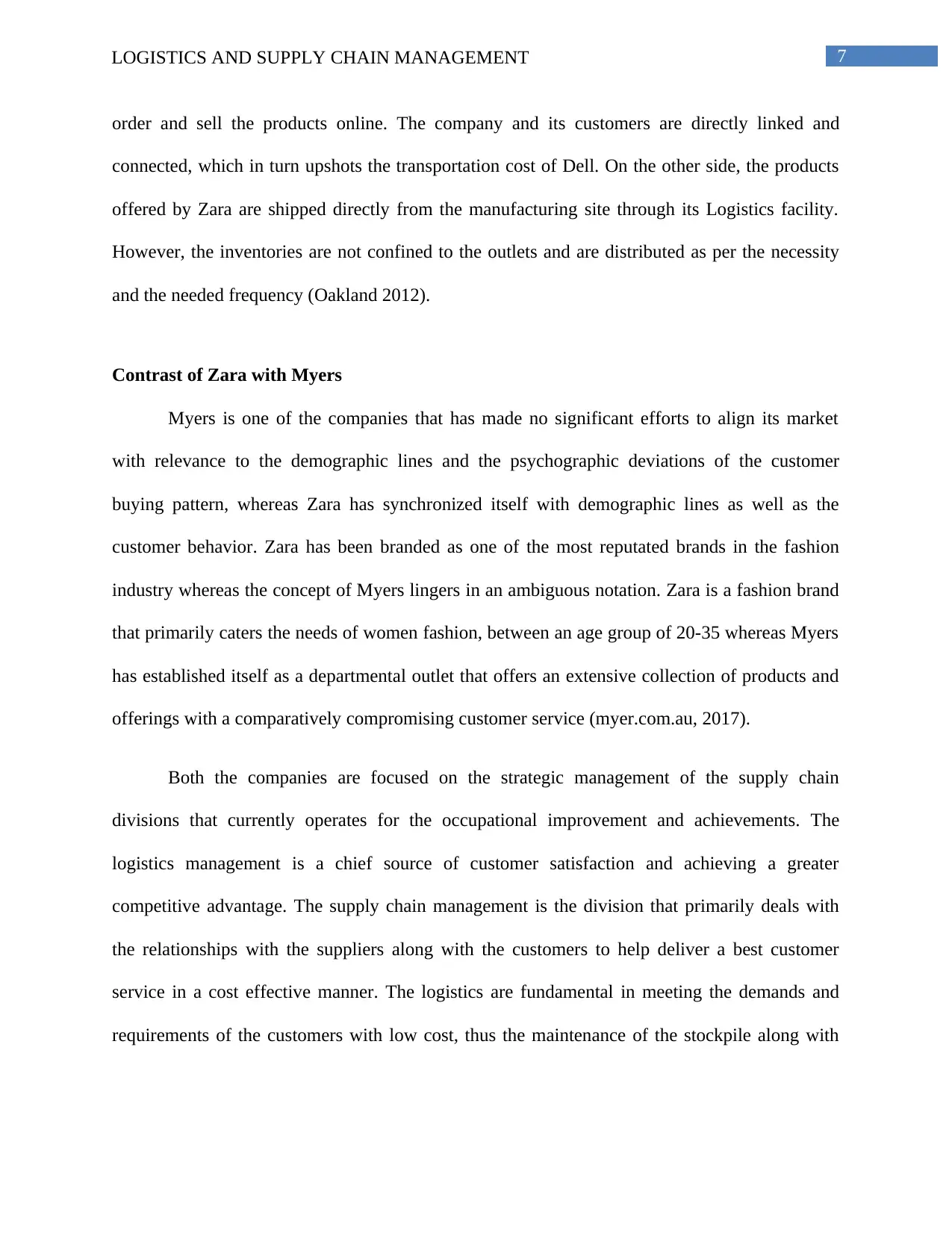
7LOGISTICS AND SUPPLY CHAIN MANAGEMENT
order and sell the products online. The company and its customers are directly linked and
connected, which in turn upshots the transportation cost of Dell. On the other side, the products
offered by Zara are shipped directly from the manufacturing site through its Logistics facility.
However, the inventories are not confined to the outlets and are distributed as per the necessity
and the needed frequency (Oakland 2012).
Contrast of Zara with Myers
Myers is one of the companies that has made no significant efforts to align its market
with relevance to the demographic lines and the psychographic deviations of the customer
buying pattern, whereas Zara has synchronized itself with demographic lines as well as the
customer behavior. Zara has been branded as one of the most reputated brands in the fashion
industry whereas the concept of Myers lingers in an ambiguous notation. Zara is a fashion brand
that primarily caters the needs of women fashion, between an age group of 20-35 whereas Myers
has established itself as a departmental outlet that offers an extensive collection of products and
offerings with a comparatively compromising customer service (myer.com.au, 2017).
Both the companies are focused on the strategic management of the supply chain
divisions that currently operates for the occupational improvement and achievements. The
logistics management is a chief source of customer satisfaction and achieving a greater
competitive advantage. The supply chain management is the division that primarily deals with
the relationships with the suppliers along with the customers to help deliver a best customer
service in a cost effective manner. The logistics are fundamental in meeting the demands and
requirements of the customers with low cost, thus the maintenance of the stockpile along with
order and sell the products online. The company and its customers are directly linked and
connected, which in turn upshots the transportation cost of Dell. On the other side, the products
offered by Zara are shipped directly from the manufacturing site through its Logistics facility.
However, the inventories are not confined to the outlets and are distributed as per the necessity
and the needed frequency (Oakland 2012).
Contrast of Zara with Myers
Myers is one of the companies that has made no significant efforts to align its market
with relevance to the demographic lines and the psychographic deviations of the customer
buying pattern, whereas Zara has synchronized itself with demographic lines as well as the
customer behavior. Zara has been branded as one of the most reputated brands in the fashion
industry whereas the concept of Myers lingers in an ambiguous notation. Zara is a fashion brand
that primarily caters the needs of women fashion, between an age group of 20-35 whereas Myers
has established itself as a departmental outlet that offers an extensive collection of products and
offerings with a comparatively compromising customer service (myer.com.au, 2017).
Both the companies are focused on the strategic management of the supply chain
divisions that currently operates for the occupational improvement and achievements. The
logistics management is a chief source of customer satisfaction and achieving a greater
competitive advantage. The supply chain management is the division that primarily deals with
the relationships with the suppliers along with the customers to help deliver a best customer
service in a cost effective manner. The logistics are fundamental in meeting the demands and
requirements of the customers with low cost, thus the maintenance of the stockpile along with
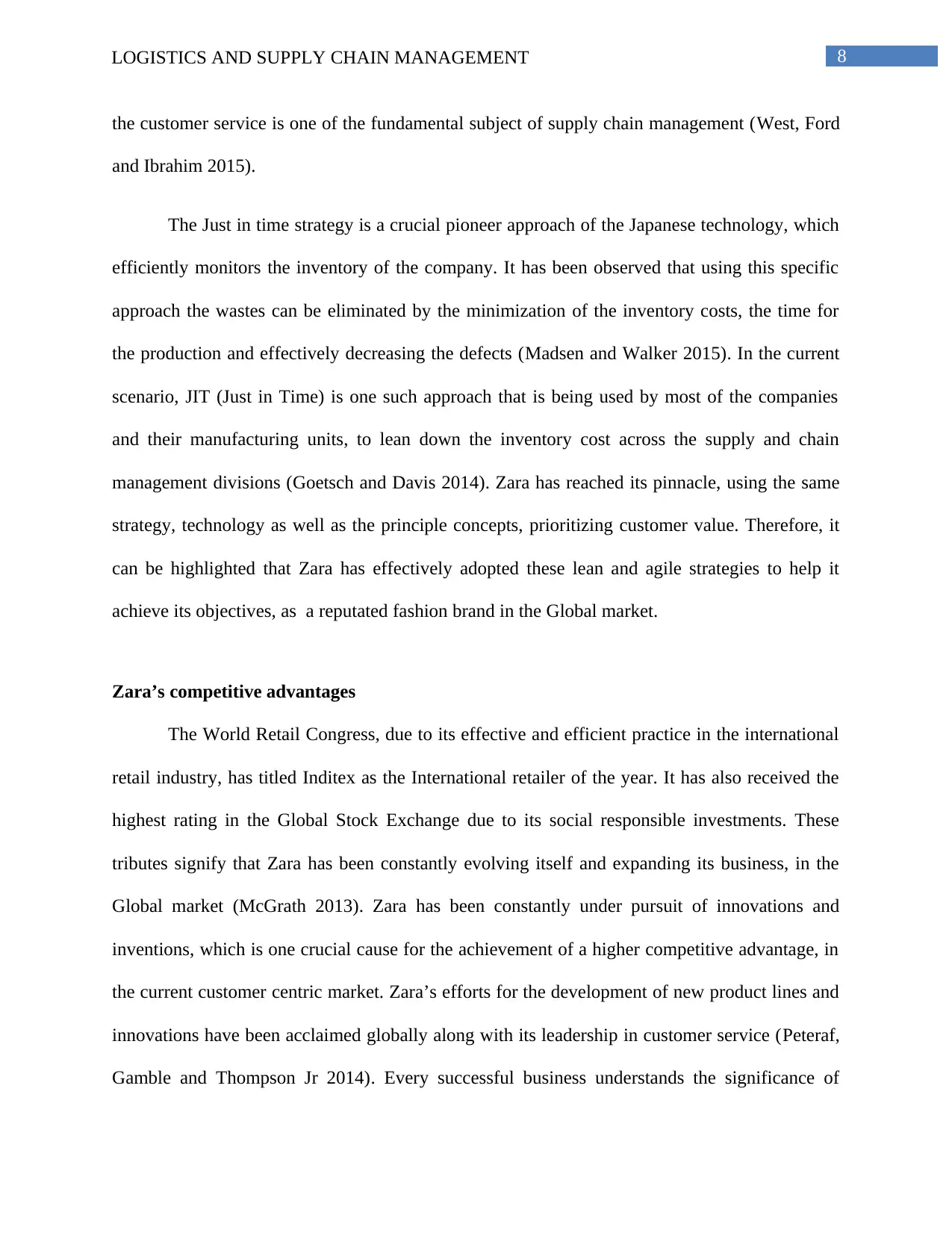
8LOGISTICS AND SUPPLY CHAIN MANAGEMENT
the customer service is one of the fundamental subject of supply chain management (West, Ford
and Ibrahim 2015).
The Just in time strategy is a crucial pioneer approach of the Japanese technology, which
efficiently monitors the inventory of the company. It has been observed that using this specific
approach the wastes can be eliminated by the minimization of the inventory costs, the time for
the production and effectively decreasing the defects (Madsen and Walker 2015). In the current
scenario, JIT (Just in Time) is one such approach that is being used by most of the companies
and their manufacturing units, to lean down the inventory cost across the supply and chain
management divisions (Goetsch and Davis 2014). Zara has reached its pinnacle, using the same
strategy, technology as well as the principle concepts, prioritizing customer value. Therefore, it
can be highlighted that Zara has effectively adopted these lean and agile strategies to help it
achieve its objectives, as a reputated fashion brand in the Global market.
Zara’s competitive advantages
The World Retail Congress, due to its effective and efficient practice in the international
retail industry, has titled Inditex as the International retailer of the year. It has also received the
highest rating in the Global Stock Exchange due to its social responsible investments. These
tributes signify that Zara has been constantly evolving itself and expanding its business, in the
Global market (McGrath 2013). Zara has been constantly under pursuit of innovations and
inventions, which is one crucial cause for the achievement of a higher competitive advantage, in
the current customer centric market. Zara’s efforts for the development of new product lines and
innovations have been acclaimed globally along with its leadership in customer service (Peteraf,
Gamble and Thompson Jr 2014). Every successful business understands the significance of
the customer service is one of the fundamental subject of supply chain management (West, Ford
and Ibrahim 2015).
The Just in time strategy is a crucial pioneer approach of the Japanese technology, which
efficiently monitors the inventory of the company. It has been observed that using this specific
approach the wastes can be eliminated by the minimization of the inventory costs, the time for
the production and effectively decreasing the defects (Madsen and Walker 2015). In the current
scenario, JIT (Just in Time) is one such approach that is being used by most of the companies
and their manufacturing units, to lean down the inventory cost across the supply and chain
management divisions (Goetsch and Davis 2014). Zara has reached its pinnacle, using the same
strategy, technology as well as the principle concepts, prioritizing customer value. Therefore, it
can be highlighted that Zara has effectively adopted these lean and agile strategies to help it
achieve its objectives, as a reputated fashion brand in the Global market.
Zara’s competitive advantages
The World Retail Congress, due to its effective and efficient practice in the international
retail industry, has titled Inditex as the International retailer of the year. It has also received the
highest rating in the Global Stock Exchange due to its social responsible investments. These
tributes signify that Zara has been constantly evolving itself and expanding its business, in the
Global market (McGrath 2013). Zara has been constantly under pursuit of innovations and
inventions, which is one crucial cause for the achievement of a higher competitive advantage, in
the current customer centric market. Zara’s efforts for the development of new product lines and
innovations have been acclaimed globally along with its leadership in customer service (Peteraf,
Gamble and Thompson Jr 2014). Every successful business understands the significance of
⊘ This is a preview!⊘
Do you want full access?
Subscribe today to unlock all pages.

Trusted by 1+ million students worldwide
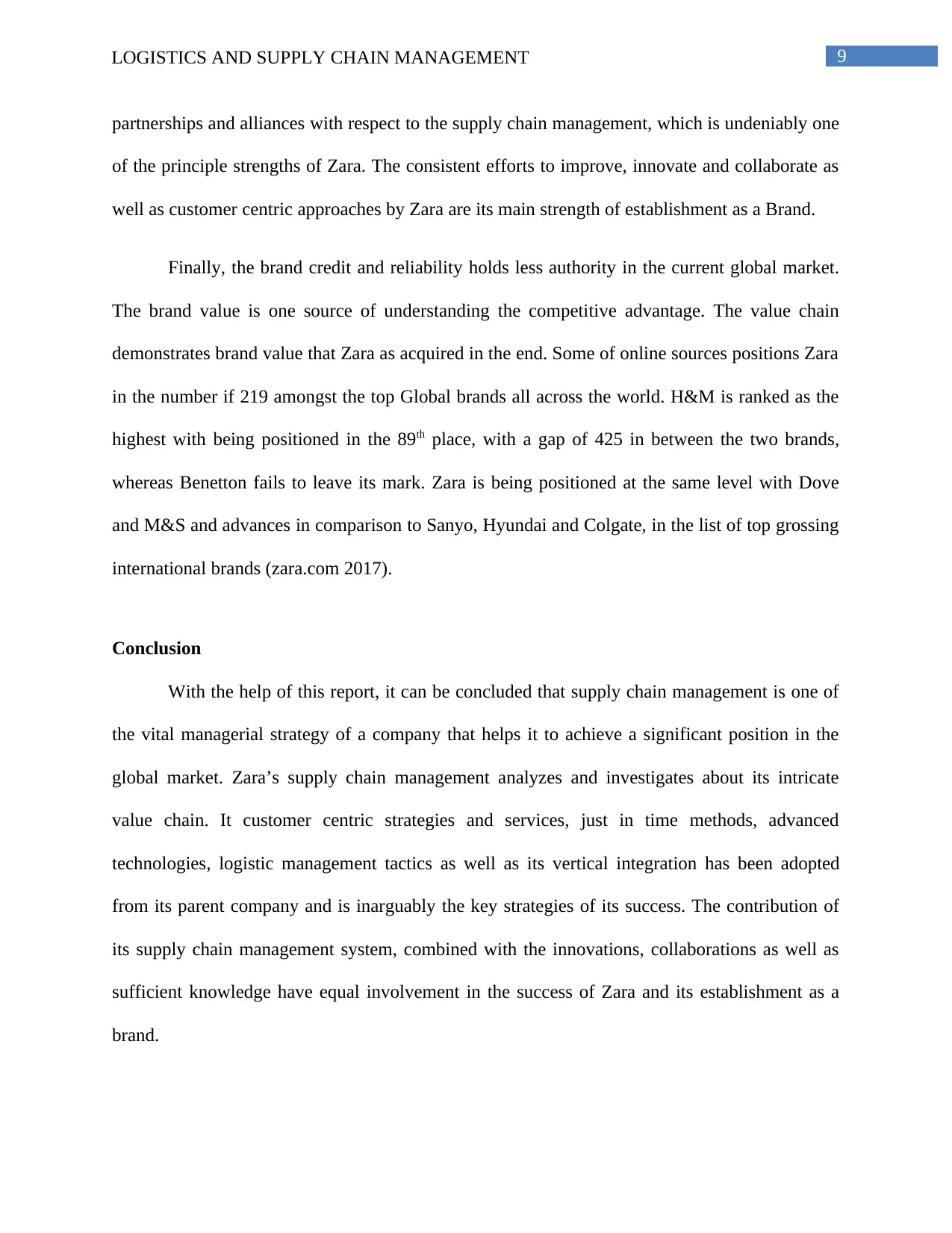
9LOGISTICS AND SUPPLY CHAIN MANAGEMENT
partnerships and alliances with respect to the supply chain management, which is undeniably one
of the principle strengths of Zara. The consistent efforts to improve, innovate and collaborate as
well as customer centric approaches by Zara are its main strength of establishment as a Brand.
Finally, the brand credit and reliability holds less authority in the current global market.
The brand value is one source of understanding the competitive advantage. The value chain
demonstrates brand value that Zara as acquired in the end. Some of online sources positions Zara
in the number if 219 amongst the top Global brands all across the world. H&M is ranked as the
highest with being positioned in the 89th place, with a gap of 425 in between the two brands,
whereas Benetton fails to leave its mark. Zara is being positioned at the same level with Dove
and M&S and advances in comparison to Sanyo, Hyundai and Colgate, in the list of top grossing
international brands (zara.com 2017).
Conclusion
With the help of this report, it can be concluded that supply chain management is one of
the vital managerial strategy of a company that helps it to achieve a significant position in the
global market. Zara’s supply chain management analyzes and investigates about its intricate
value chain. It customer centric strategies and services, just in time methods, advanced
technologies, logistic management tactics as well as its vertical integration has been adopted
from its parent company and is inarguably the key strategies of its success. The contribution of
its supply chain management system, combined with the innovations, collaborations as well as
sufficient knowledge have equal involvement in the success of Zara and its establishment as a
brand.
partnerships and alliances with respect to the supply chain management, which is undeniably one
of the principle strengths of Zara. The consistent efforts to improve, innovate and collaborate as
well as customer centric approaches by Zara are its main strength of establishment as a Brand.
Finally, the brand credit and reliability holds less authority in the current global market.
The brand value is one source of understanding the competitive advantage. The value chain
demonstrates brand value that Zara as acquired in the end. Some of online sources positions Zara
in the number if 219 amongst the top Global brands all across the world. H&M is ranked as the
highest with being positioned in the 89th place, with a gap of 425 in between the two brands,
whereas Benetton fails to leave its mark. Zara is being positioned at the same level with Dove
and M&S and advances in comparison to Sanyo, Hyundai and Colgate, in the list of top grossing
international brands (zara.com 2017).
Conclusion
With the help of this report, it can be concluded that supply chain management is one of
the vital managerial strategy of a company that helps it to achieve a significant position in the
global market. Zara’s supply chain management analyzes and investigates about its intricate
value chain. It customer centric strategies and services, just in time methods, advanced
technologies, logistic management tactics as well as its vertical integration has been adopted
from its parent company and is inarguably the key strategies of its success. The contribution of
its supply chain management system, combined with the innovations, collaborations as well as
sufficient knowledge have equal involvement in the success of Zara and its establishment as a
brand.
Paraphrase This Document
Need a fresh take? Get an instant paraphrase of this document with our AI Paraphraser
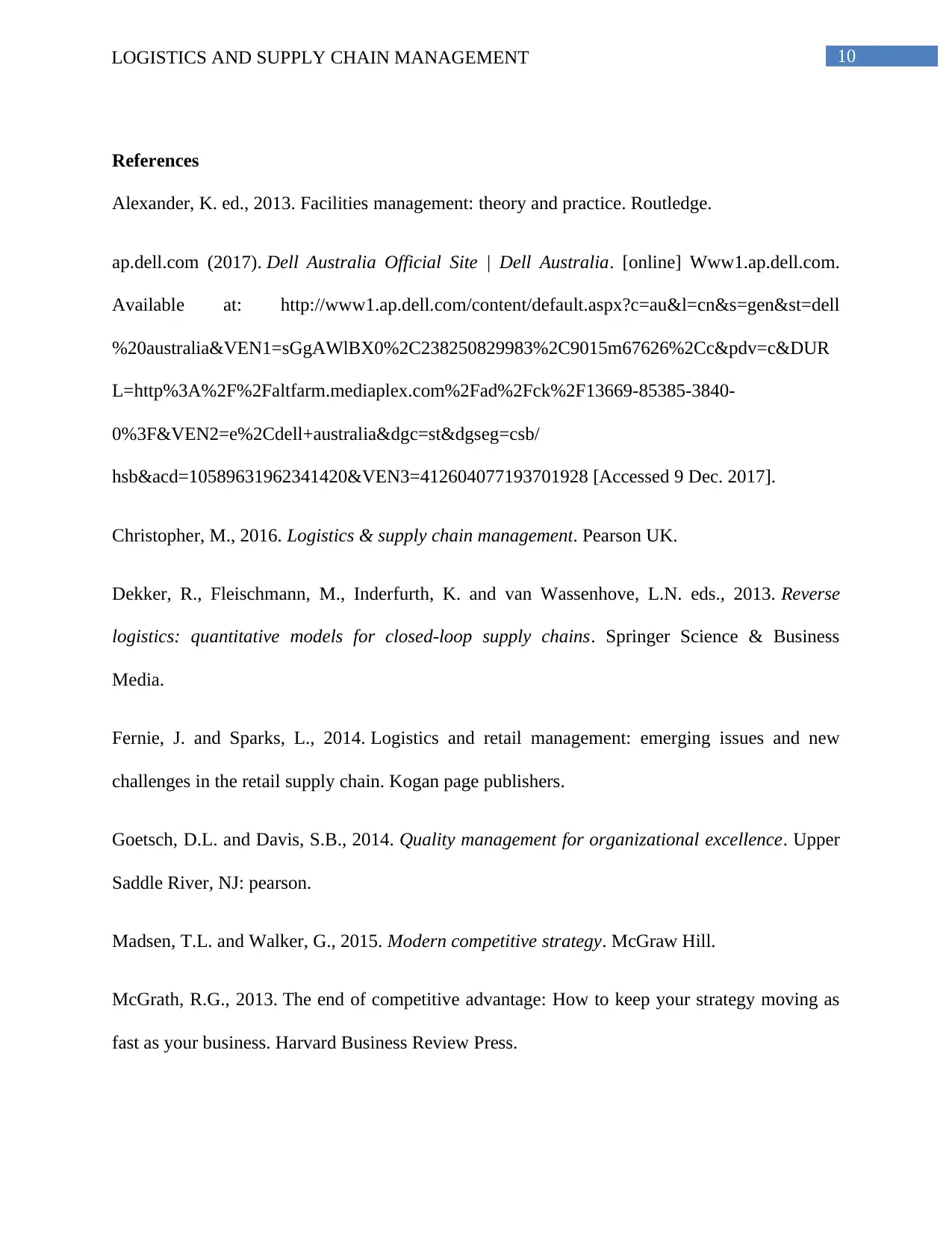
10LOGISTICS AND SUPPLY CHAIN MANAGEMENT
References
Alexander, K. ed., 2013. Facilities management: theory and practice. Routledge.
ap.dell.com (2017). Dell Australia Official Site | Dell Australia. [online] Www1.ap.dell.com.
Available at: http://www1.ap.dell.com/content/default.aspx?c=au&l=cn&s=gen&st=dell
%20australia&VEN1=sGgAWlBX0%2C238250829983%2C9015m67626%2Cc&pdv=c&DUR
L=http%3A%2F%2Faltfarm.mediaplex.com%2Fad%2Fck%2F13669-85385-3840-
0%3F&VEN2=e%2Cdell+australia&dgc=st&dgseg=csb/
hsb&acd=10589631962341420&VEN3=412604077193701928 [Accessed 9 Dec. 2017].
Christopher, M., 2016. Logistics & supply chain management. Pearson UK.
Dekker, R., Fleischmann, M., Inderfurth, K. and van Wassenhove, L.N. eds., 2013. Reverse
logistics: quantitative models for closed-loop supply chains. Springer Science & Business
Media.
Fernie, J. and Sparks, L., 2014. Logistics and retail management: emerging issues and new
challenges in the retail supply chain. Kogan page publishers.
Goetsch, D.L. and Davis, S.B., 2014. Quality management for organizational excellence. Upper
Saddle River, NJ: pearson.
Madsen, T.L. and Walker, G., 2015. Modern competitive strategy. McGraw Hill.
McGrath, R.G., 2013. The end of competitive advantage: How to keep your strategy moving as
fast as your business. Harvard Business Review Press.
References
Alexander, K. ed., 2013. Facilities management: theory and practice. Routledge.
ap.dell.com (2017). Dell Australia Official Site | Dell Australia. [online] Www1.ap.dell.com.
Available at: http://www1.ap.dell.com/content/default.aspx?c=au&l=cn&s=gen&st=dell
%20australia&VEN1=sGgAWlBX0%2C238250829983%2C9015m67626%2Cc&pdv=c&DUR
L=http%3A%2F%2Faltfarm.mediaplex.com%2Fad%2Fck%2F13669-85385-3840-
0%3F&VEN2=e%2Cdell+australia&dgc=st&dgseg=csb/
hsb&acd=10589631962341420&VEN3=412604077193701928 [Accessed 9 Dec. 2017].
Christopher, M., 2016. Logistics & supply chain management. Pearson UK.
Dekker, R., Fleischmann, M., Inderfurth, K. and van Wassenhove, L.N. eds., 2013. Reverse
logistics: quantitative models for closed-loop supply chains. Springer Science & Business
Media.
Fernie, J. and Sparks, L., 2014. Logistics and retail management: emerging issues and new
challenges in the retail supply chain. Kogan page publishers.
Goetsch, D.L. and Davis, S.B., 2014. Quality management for organizational excellence. Upper
Saddle River, NJ: pearson.
Madsen, T.L. and Walker, G., 2015. Modern competitive strategy. McGraw Hill.
McGrath, R.G., 2013. The end of competitive advantage: How to keep your strategy moving as
fast as your business. Harvard Business Review Press.
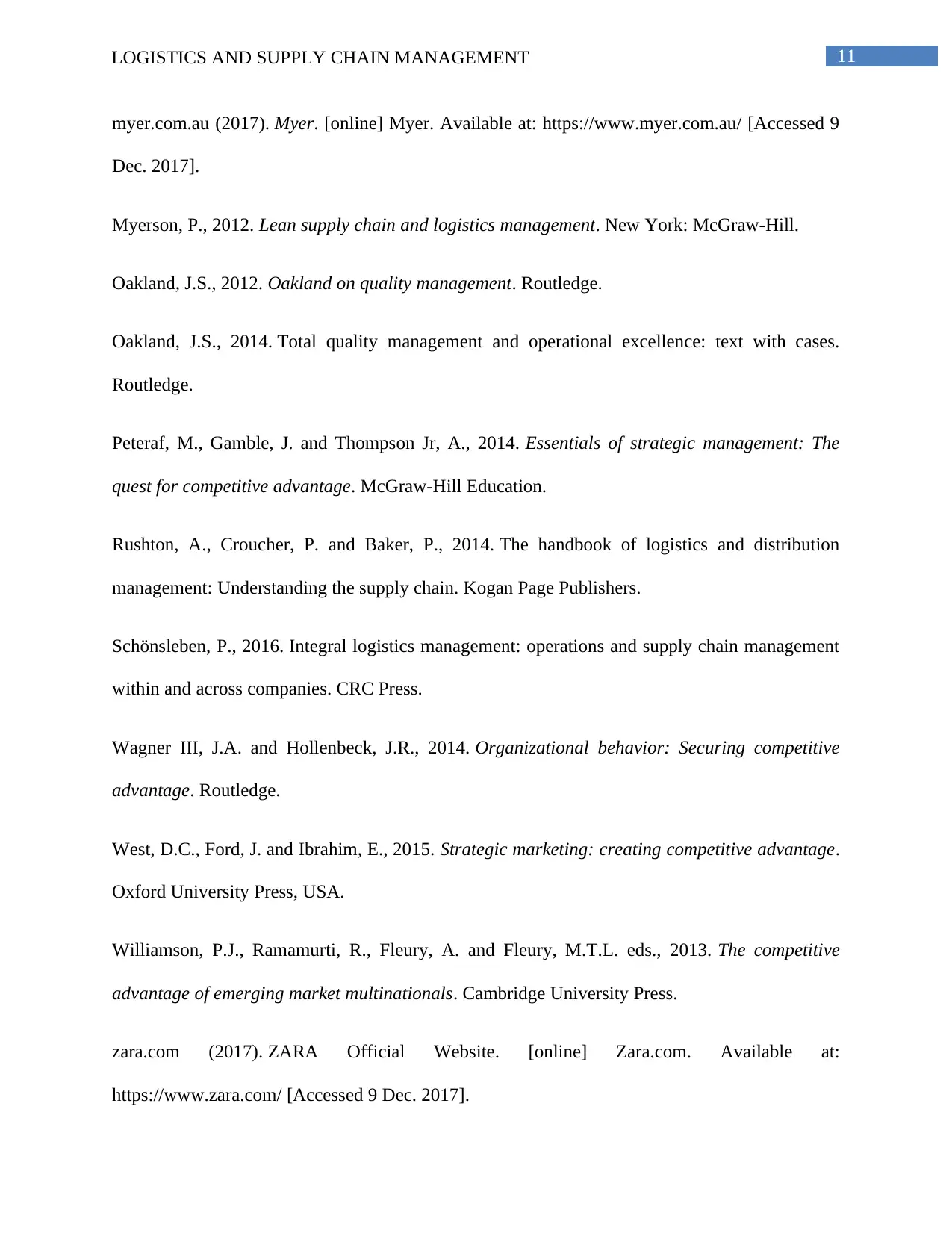
11LOGISTICS AND SUPPLY CHAIN MANAGEMENT
myer.com.au (2017). Myer. [online] Myer. Available at: https://www.myer.com.au/ [Accessed 9
Dec. 2017].
Myerson, P., 2012. Lean supply chain and logistics management. New York: McGraw-Hill.
Oakland, J.S., 2012. Oakland on quality management. Routledge.
Oakland, J.S., 2014. Total quality management and operational excellence: text with cases.
Routledge.
Peteraf, M., Gamble, J. and Thompson Jr, A., 2014. Essentials of strategic management: The
quest for competitive advantage. McGraw-Hill Education.
Rushton, A., Croucher, P. and Baker, P., 2014. The handbook of logistics and distribution
management: Understanding the supply chain. Kogan Page Publishers.
Schönsleben, P., 2016. Integral logistics management: operations and supply chain management
within and across companies. CRC Press.
Wagner III, J.A. and Hollenbeck, J.R., 2014. Organizational behavior: Securing competitive
advantage. Routledge.
West, D.C., Ford, J. and Ibrahim, E., 2015. Strategic marketing: creating competitive advantage.
Oxford University Press, USA.
Williamson, P.J., Ramamurti, R., Fleury, A. and Fleury, M.T.L. eds., 2013. The competitive
advantage of emerging market multinationals. Cambridge University Press.
zara.com (2017). ZARA Official Website. [online] Zara.com. Available at:
https://www.zara.com/ [Accessed 9 Dec. 2017].
myer.com.au (2017). Myer. [online] Myer. Available at: https://www.myer.com.au/ [Accessed 9
Dec. 2017].
Myerson, P., 2012. Lean supply chain and logistics management. New York: McGraw-Hill.
Oakland, J.S., 2012. Oakland on quality management. Routledge.
Oakland, J.S., 2014. Total quality management and operational excellence: text with cases.
Routledge.
Peteraf, M., Gamble, J. and Thompson Jr, A., 2014. Essentials of strategic management: The
quest for competitive advantage. McGraw-Hill Education.
Rushton, A., Croucher, P. and Baker, P., 2014. The handbook of logistics and distribution
management: Understanding the supply chain. Kogan Page Publishers.
Schönsleben, P., 2016. Integral logistics management: operations and supply chain management
within and across companies. CRC Press.
Wagner III, J.A. and Hollenbeck, J.R., 2014. Organizational behavior: Securing competitive
advantage. Routledge.
West, D.C., Ford, J. and Ibrahim, E., 2015. Strategic marketing: creating competitive advantage.
Oxford University Press, USA.
Williamson, P.J., Ramamurti, R., Fleury, A. and Fleury, M.T.L. eds., 2013. The competitive
advantage of emerging market multinationals. Cambridge University Press.
zara.com (2017). ZARA Official Website. [online] Zara.com. Available at:
https://www.zara.com/ [Accessed 9 Dec. 2017].
⊘ This is a preview!⊘
Do you want full access?
Subscribe today to unlock all pages.

Trusted by 1+ million students worldwide
1 out of 12
Related Documents
Your All-in-One AI-Powered Toolkit for Academic Success.
+13062052269
info@desklib.com
Available 24*7 on WhatsApp / Email
![[object Object]](/_next/static/media/star-bottom.7253800d.svg)
Unlock your academic potential
Copyright © 2020–2025 A2Z Services. All Rights Reserved. Developed and managed by ZUCOL.



